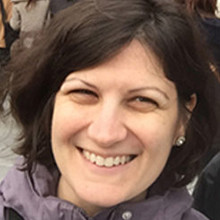COVID-19 Governance Series: Alexandra Scacco and Maarten Voors


Author: Jaclyn Leaver
In today’s COVID-19 Governance Series we feature an interview with EGAP members Alexandra Scacco (WZB Berlin Social Science Center) and Maarten Voors (Wageningen University), who spoke on behalf of the research team, about their recent Nature Medicine article “COVID-19 vaccine acceptance and hesitancy in low- and middle-income countries.” This multi-country study was a collaborative effort involving more than 70 authors, including 10 EGAP members.
Your study looks at the importance of addressing COVID-19 vaccine hesitancy to ensure sufficient immunization coverage across the globe. What motivated you to study this question?
Alexandra Scacco and Maarten Voors: Ensuring widespread access to safe and effective vaccines is crucial for controlling the pandemic and is therefore an urgent political and policy problem. As of July 2021, many COVID-19 vaccines have been approved, but the global distribution of these vaccines remains highly unequal. Most of the supply continues to be directed toward high-income countries. In addition to vaccine availability, trust in available COVID-19 vaccines and the institutions that administer them are key determinants of the success of any vaccination campaign. While several recent studies have investigated willingness to take a COVID-19 vaccine in high-income countries, our goal was to provide insights into vaccine acceptance and hesitancy in a broad set of lower income countries, where large-scale vaccination has not yet taken place. Our study includes data from 15 survey samples from ten low- and middle-income countries in Africa, Asia, and South America, as well as Russia (an upper-middle income country) and the United States.
Your study finds high levels of willingness to take a COVID-19 vaccine across ten low- and middle-income countries (LMICs) in Asia, Africa, and South America but much lower levels of willingness in the two higher income countries, Russia and the United States, where you conducted the study. What are the main reasons why people in these LMICs expressed a high degree of acceptance? What are the primary reasons given for hesitancy?
AS and MV: We do find striking and consistent high levels of COVID-19 vaccine acceptance across the LMICs in our study. On average, 80% (median 78%, range 30%) of LMIC study respondents reported that they would be willing to take a COVID-19 vaccine if it became available. Vaccine acceptance is notably lower in both the USA (65%) and Russia (30%). To better understand the reasoning behind these expressed attitudes, we asked study participants who said they would be willing to take the vaccine why they would take it. Across studies, the primary motivation was an interest in personal protection against COVID-19. We also asked hesitant respondents why they would not take the vaccine. By a clear margin, the main reason given for expressed hesitancy was concern about side effects from vaccination. This concern was particularly salient in our samples from sub-Saharan Africa. Another noteworthy finding is that respondents in our study’s LMIC samples rarely cited conspiracy theories (for example, about nefarious intentions on the part of governments or corporations) that have received widespread attention in higher-income countries.
What are the methods that you used in the study, and then what would you say are the strengths and limitations based on the methodology?
AS and MV: We were interested in expressed willingness to take a COVID-19 vaccine during the period before such vaccines became widely available, as well as reasons why people would or would not be willing to do so, and in the most trusted sources of information during respondents’ decision-making processes. To select research sites, we conducted an internal search within the International Growth Center (IGC), Innovations for Poverty Action (IPA), and the Berlin Social Science Center (WZB) for projects with plans to collect survey data in the second half of 2020. Study PIs agreed to include a set of common questions about the COVID-19 vaccine attitudes mentioned above. Our strategy was guided by the need to collect information quickly and cost-effectively using survey modalities that were safe, given pandemic conditions, and appropriate for contexts with limited internet coverage. As such, it is important to note that our data are therefore not necessarily representative of all LMICs. Further, the samples from the countries included in our study are not all nationally representative. Most surveys included in our study were conducted by phone or online — a necessity during a global pandemic — and several relied on subnational samples of respondents drawn from ongoing surveys, to which questions about COVID-19 vaccination were added. Care should be taken in extrapolating findings from these samples to national populations. That said, in spite of the variation in sample composition, we were struck by the remarkable consistency of our core finding — of high COVID-19 vaccine acceptance in LMICs relative to the USA and Russia — across samples. A series of robustness checks further suggest that these results are not driven by the peculiarities of one or two studies.
What are the key implications of your study? What kinds of interventions would you propose to increase vaccine take-up in LMICs?
AS and MV: We highlight what we see as three key implications. First and foremost, given consistently high levels of COVID-19 vaccine acceptance, our research suggests that prioritizing vaccine distribution to LMICs is important not only for reasons of equity, but is likely to yield higher marginal returns in maximizing global coverage more quickly than targeting smaller numbers in high-income countries.
Second, the high levels of acceptance we observe in our LMIC samples suggest that, rather than investing the bulk of their resources in attempts (for example, via messaging interventions) to persuade skeptics, interventions in our study countries should focus on translating pro-vaccine attitudes into vaccine uptake. For example, “last-mile” nudges — such as alerts about vaccine availability and reminder messages about already scheduled vaccine appointments — to make it as easy as possible for people to follow through with intentions to get vaccinated.
Third, a clear and consistent conclusion from our study is that health workers with relevant expertise — rather than celebrities or other public figures — are the most trusted source of information about COVID-19 vaccination. As such, health workers are ideally placed to deliver vaccination-related messages in the LMICs included in our study.